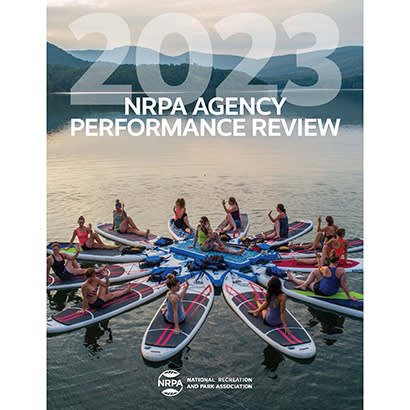
For an enhanced digital experience, read this story in the ezine.
Determining where your agency falls amongst its peers can assist in guiding the direction your agency takes for the future. The 2023 NRPA Agency Performance Review summarizes key findings of more than 1,000 unique park and recreation agencies across the United States on varying topics — from facility type to policies. The findings within the review are compiled using agency-submitted data contributed to NRPA Park Metrics, the benchmarking resource that assists park and recreation professionals in the effective management and planning of their operating resources and capital facilities. The combination of insights from this report and NRPA Park Metrics, along with information about your community’s specific needs and experiences, will help identify the optimal mix of facilities and programming being delivered by you and your peers.
The 2023 NRPA Agency Performance Review does not present park and recreation “standards,” nor do the benchmarks represent any standards against which every individual park and recreation agency should measure itself. The reason for this is simple: there is not one single set of standards for parks and recreation because different agencies serve different communities that have unique needs, desires and challenges. Throughout the report, data are presented on the “typical” agency, which represents the statistical median of the data. Additional cross-tabulations by jurisdiction population or population density also are presented within the report and more comprehensive cross-tabulations, including budget size, region, jurisdiction type and more, are available as interactive tables.
Key findings from the 2023 NRPA Agency Performance Review include:
Park Facilities
- There is typically one park for every 2,287 residents.
- The typical park and recreation agency has 10.8 acres of parkland for every 1,000 residents in the jurisdiction.
- An overwhelming majority of park and recreation agencies have playgrounds (95 percent) and basketball courts (86 percent) in their portfolio of assets.
- The typical park and recreation agency manages or maintains 15 miles of trails for walking, hiking, running and/or biking.
- A majority of agencies offer community centers and recreation centers; 2 in 5 agencies offer senior centers.
Programming
- Key programming activities include themed special events, social recreation events, team sports, fitness enhancement classes, and health and wellness education.
- Eighty-two percent of agencies offer summer camp for their communities’ younger residents.
Responsibilities of Park and Recreation Agencies
- Top roles include operating and maintaining parks, trails and indoor facilities; providing recreation programming and services; and conducting jurisdiction-wide special events.
- Operating, maintaining or contracting special purpose parks, pools and racquet sports areas lead the list of other agency responsibilities.
Staffing
- The typical park and recreation agency has a payroll of 51.5 full-time equivalent staff (FTEs).
- The typical park and recreation agency has 8.9 FTEs on staff for each 10,000 residents in the jurisdiction served by the agency.
- Operations and maintenance, programming and administration are the primary responsibilities of park and recreation workers.
Budget
- The typical park and recreation agency has annual operating expenditures of $5.5 million.
- The typical park and recreation agency has annual operating expenses of $94.77 on a per capita basis.
- The median level of operating expenditures is $7,388 per acre of park and non-park sites managed by the agency.
- The typical park and recreation agency spends $105,484 in annual operating expenditures for each employee.
- At the typical park and recreation agency, staffing costs account for 55 percent of the operating budget.
- The typical park and recreation agency dedicates 46 percent of its operating budget to park management and maintenance and 41 percent to recreation.
Funding
- Park and recreation agencies derive 61 percent of their operating expenditures from general fund tax support.
- The typical park and recreation agency generates $21.71 in revenue annually for each resident in the jurisdiction.
- The typical park and recreation agency recovers, on average, 24.6 percent of its operating expenditures from non-tax revenue.
- Park and recreation agencies will spend a median of $10 million in capital expenditures budgeted during the next five years.
- On average, 55 percent of the capital budget is designated for renovation, while 31 percent is geared toward new development.
- On average, park and recreation agencies have $16.5 million of deferred maintenance projects on their books.
Policies
- Four in five park and recreation agencies ban the use of tobacco products at most/all of their parks and facilities.
- Eighty-one percent of park and recreation agencies have an expressed commitment to DEI in their foundational documents (e.g., vision, mission and strategic plan documents).
- Ninety percent of park and recreation agencies have hiring practices and policies that promote a diverse workforce.
Next Steps
- Dig deeper into the 2023 NRPA Agency Performance Review data using the interactive tools.
- Create a Park Metrics account.
- Find peer agencies in NRPA Park Metrics by filtering the data by agency type, size, budget, geographic region and more.
- Enhance your NRPA Park Metrics experience by entering your agency’s data to compare it with the key metrics of agencies throughout the United States.
Thank You
The NRPA Research team would like to acknowledge all those who made this report possible through their continued sharing of data and of time. Your contributions to NRPA Park Metrics advance the field and are incredibly appreciated.
Melissa May is Senior Research Manager at NRPA

